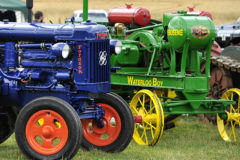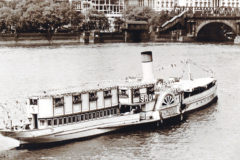Superb 1936 N1 Commer restoration
Posted by Chris Graham on 29th October 2021
Bob Tuck spotlights 1936 N1 Commer, and recounts the time and effort required to bring this fine slice of heritage back to life.

1936 N1 Commer: This Commer was built with a capacity of just over a ton – 20/25cwt. The same sort of capacity of the modern day Transit style of van.
Ask Joe Stamper what’s his preference and he’ll tell you in a flash: “I’ve never really liked coffee at all,” he says, “so it’s always been a brew of tea for me.” He adds a big smile to his reply because of course for the last 11 years or so, Joe’s been something of a crusader to this preferred choice of drink. Yes, ever since he took over ownership of the 1936 Commer N1 which has been lovingly restored into the original livery of its first owner J Lyons and Co, then his ‘Tea Van’ has been a regular sight in the area around his home town of Burton upon Trent. And even though the elements weren’t at their best when Heritage Commercials was invited to see this special slice of transport history, they couldn’t spoil the sheer gush of radiance this Commer gives out from every pore of its polished skin.

When Joe discovered this period image of a similar Commer N1 to his, he decided to try and re-create the appearance as it looked during the Second World War (apart from being fitted with the gas bag conversion of course).
The first food empire
If you are of a certain age then you’ll be well aware of the J Lyons & Co name. Established in 1894, they were originally a London based operation with their HQ being at Cadby Hall. From 1909 Lyons were to develop their own style of Corner Shop Tea Rooms and if you thought the likes of Starbucks and Costa were recent trailblazers in this sort of High Street activity, then think again as Lyons were building this sort of network 100 years ago.
Expanding across the country, the family owned concern were particularly go-ahead as they got into everything from hotels to Lyons’ Maid ice cream. At the start of the ‘50s, they were even at the forefront of developing computers for office use. However, it was the cakes and confectionery which took their name all round the globe – a brand name which meant a sure sign of quality in the highly competitive bakery world.

When Geoff Mellor bought the Commer in ’88, this was the vehicle he started with. Geoff recalls that although some parts were missing, these were inside the back of the van. Picture – Geoff Mellor
Getting their wares out to their customers in the UK saw a big investment in a distribution operation. To start with – around London – horses and carts were used although by 1908, they introduced their motorised van fleet which subsequently was to utilise all shapes and sizes and makes of motor to transport their wares. In 1936, specially bodied versions of the Commer N1 – just like Joe’s one – was being put out to service in all parts of the country: “In big towns like Burton,” Joe tells us, “there would be two of this type of van based here. My good friend George Wood has told me that he can recall where these Lyons’ vans were both garaged close to the railway station.”
As well as supplying a variety of shop outlets in town, they would also serve the local villages: “I can imagine they would have regular routes they’d work each day / week,” says Joe, “to ensure as many places as possible were visited. Once they’d reached the centre of a village, the drivers would sound a hand bell to tell the locals they were there and open for business.”

The body was taken off the Commer’s chassis and the restoration carried out in two different parts. Picture – Geoff Mellor
As a source of extra information, Joe quotes extracts from author Peter Bird’s huge book on the Lyons’ history ‘The First Food Empire.’ “The drivers of the cash sales vans were not only good salesmen but were taught to drive and keep their own accounts for paying the cash into local banks. They were organised under 14 different local supervisors. Among the hundreds of journeys made every year, some consisted of a few square miles in a city, while others might extend to several hundred square miles in larger territories like Scotland. In 1954, 60,000 journeys were made by Lyons’ vehicles. Every trip was planned to a strict time table, not only for orderly management, but to ensure that the shop keeper would be in his shop, with cash available and knowing when to expect his delivery. Salesmen could replenish their stock at the various depots around the country or they could order from Greenford (Lyons’ other factory in London) and collect goods either from the local railway station or at some point on the trunk road system.”

David Woolliscroft took the restoration on and this shot of David’s is taken when the Commer was enroute to get painted. Picture – David Woolliscroft
It was a system which apparently worked like clockwork, and by the ‘50s, the Lyons’ fleet had grown to a massive 2,750 vehicles although in ‘51, CXM 275 (Joe’s motor) was sold out of service. But don’t worry, destiny would ensure the pair would eventually meet up – but not until about 60 years later.
Bass rules
Joe’s home town of Burton is of course best known for a drink of another kind. It was about 250 years ago that William Bass gave his name to a brewing dynasty which eventually saw the brewers of Burton produce 25% of all the beer which was drunk in Britain. Over time, the country’s drinking habits may have changed but it’s perhaps no surprise that Joe ended up first doing work experience and then getting an apprenticeship – and a job he’s had for the last 13 years – as a maintenance engineer in the town’s brewing industry: “As a youngster,” he says, “I’d always been interested in both architecture and engineering. And while I had been into model railways, I can recall when my dad Tony first took me down to the Bass Museum. I loved trying to help with the restorations of things like an Albion A4 which were being done up back then.”

We love the classy style of body and its stunning livery.
Yes, volunteers of all ages were actively encouraged to help out – Joe’s still one of them today – with the odd perk being thrown in as a thank you: “We don’t do it now,” says Joe, “but back at the turn of the Millennium, they let us youngsters travel with these restored vehicles when they went out to local events. I loved it.” Yes, it was this seed of the preservation scene which was introduced to Joe at a very early age and in 2010 – while still at the rather young age of 19 – he fancied investing his savings in a motor of his own.
At this point, Joe established certain parameters in his own mind before looking around. “Being my first one, I didn’t fancy starting on say a wreck that would need years of work so it had to be a runner in decent order. I also wanted something small that would say fit into a garage at home but I didn’t fancy a vintage car or motor bike – it had to be a commercial.” And of course, you’ve guessed it, the ’36 Commer N1 was to come along and fit the bill with that wish list.
Strangely the vehicle was to be found through an advert on eBay: “It was the last place I thought I’d find something but it got me in touch with David Woolliscroft who was looking to find a new home for it. It took me a couple of weeks to decide whether to buy it – but I’m certainly pleased I did.” And aren’t we all.

The Commer has a four speed gearbox but Joe has found that 2nd is normally low enough to start away in.
Time passes
You don’t need us to tell you that individual restoration projects can be as varied as they come. And, it can often be impossible to predict how long it will take to see a motor back to its original condition. As we’ll explain, Joe’s involvement with the Commer has been the enhancing / completion of a project which really started way back in 1951. And he’s at pains to point out that there are some significant others involved in first saving his Commer and then pouring all sorts of time and money into its restoration so take a big bow Geoff Mellor and David Woolliscroft.
Actually Joe’s research into the life and time of his load shifter reveals it was Thomas Richard Addis of Great Missenden in Buckinghamshire who ensured the vehicle was saved when he bought it in 1951 after it had done about 15 years’ service with the Lyons’ operation. These Addis details are recorded in the Commer’s original logbook but the same DVLA records suggests the vehicle never went back onto the road until more than 50 years later.

Easy cross cab access for the Commer driver and actually there is room for three inside the cab – honest.
In the late ‘80s, it was first bought by David Maddox who, unsure what to do with it was persuaded to sell it on to his ‘Uncle-in-law’ Geoff Mellor who took on the first huge stage of its restoration. “I’d trained as a cabinet maker,” says Geoff, “and I’ve always loved to be busy restoring things although the Commer was the only commercial vehicle I ever tackled, although I’ve done agricultural tractors as I’m also in to competition ploughing. But as soon as I saw the vehicle, I took a shine to it and fancied giving the restoration a good go.”
Geoff thinks the general condition of the ’36 motor back then suggested it may have been dry stored for the previous 37 years: “It looked as though someone had perhaps started with the restoration by taking parts off. But all the bits – like the bonnet covers – were inside the van. There was even a brand new roll of canvas in there for when the roof had to be tackled.”
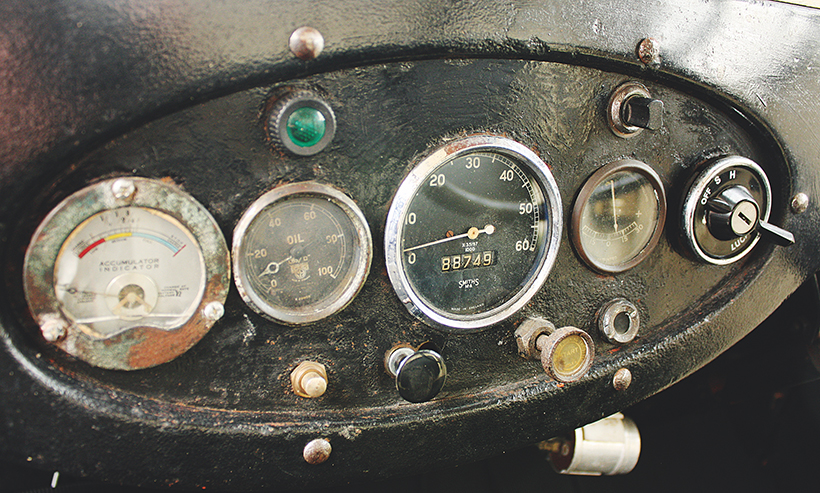
Most of the controls and dials are original. The speedometer reading rarely goes above 30mph.
Geoff decided the (very long) job had to be done in two different parts so he knew at the outset the body would have to be separated from the chassis rails. To do the mechanics, Geoff utilised the services of good friend Peter Moore at Victoria Garage in Nuneaton. After removing the engine and gearbox, Peter was able to do the rebuild buying parts and spares still stocked by Speedy Spares of Brighton. No surprise that a lot of time was spent by Geoff overhauling the chassis, brakes, rear differential and prop shaft. Once completed, the engine was returned and put back in place, along with the radiator which had been re-cored by ABN Radiators of Hinckley.
After that, he began on the woodwork around the cab although realising the vehicle would not fit in his workshop when completed, Geoff decided to move it on. “I suppose in the last 10 years I had it then I didn’t do a lot to it. I put it onto eBay but the people who got in touch were just after spare parts and things and I was really after someone interested in taking the project on.”
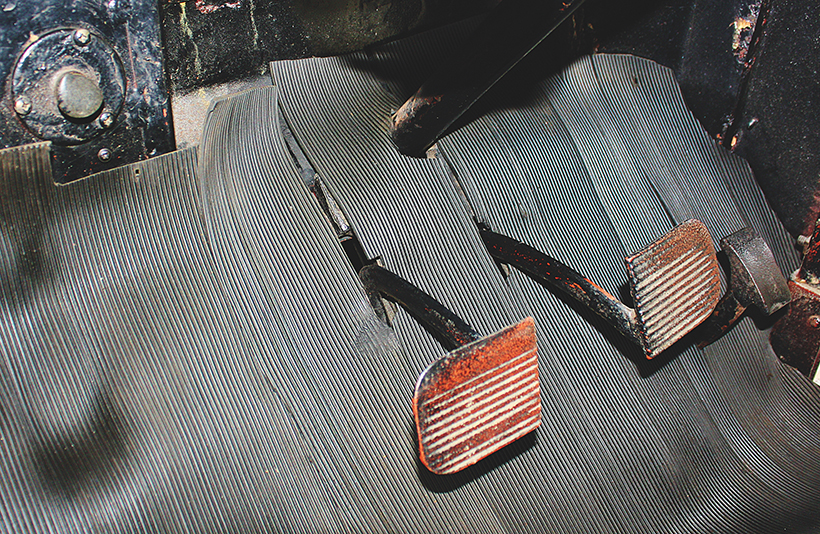
Starter button for the Commer is located on the engine bulkhead and is operated by your foot.
In ’07, Geoff was put in touch with just the man he was looking for. And it was to be David Woolliscroft – assisted by his wife Anne – who continued with the coachwork by building the ash frame and panel work. To produce the stylish front wings, David utilised the talents of good friend Mick Berry. A panel beater by trade, Mick also sorted the bonnet.
The roof of the van was to be the final hurdle although working in canvas was a new one for David so he sought assistance from his local gliding club. Here he met Bob Bowles who assisted him in fitting the new roof. The wiring loom was done by Martin Vaughn and this allowed the vehicle to return to running condition prior to its spray painting courtesy of Arch Services of Tamworth.
Move to Burton
When Joe bought the motor in ’10, it was both a runner and liveried up ready to show. However, the last 10 years has seen our man put his own stamp on it both with the mechanics and its graphics / paintwork. “The first issue to address,” says Joe, “was a water leak from the engine’s cylinder head. It had been repaired earlier but I took the head to Brian Wigginton at Stitch Weld in Burton to be sorted. Then with assistance of good friend Mick Wheeler we overhauled the fuel pump and oil pump fitting new gaskets all round. The gearbox was removed and overhauled along with a new clutch supplied by Truck Fix.”
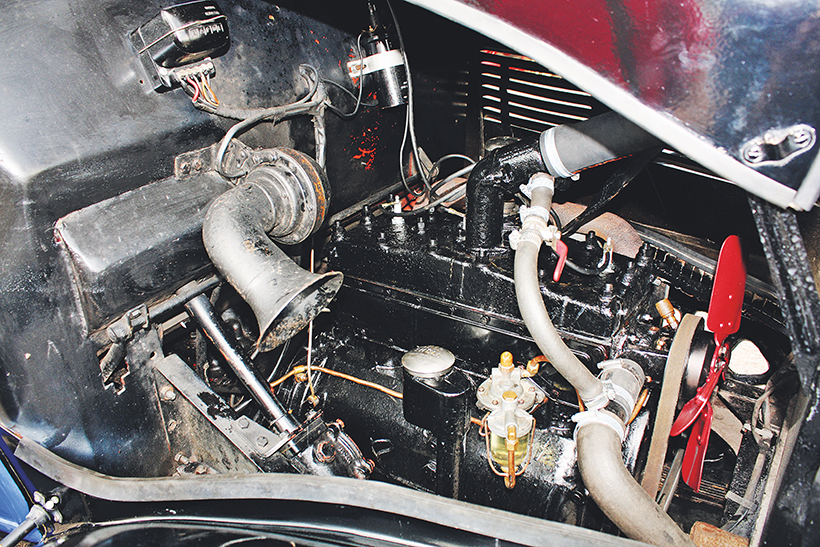
Joe tells us that the engine from his N1 started life in a Hillman 14 saloon car.
It was perhaps more than apt that Alan Topliss would sort out the engine’s timing and overhaul the carburettor: “I was an apprentice under Alan,” explains Joe, “when I was first serving my time as a maintenance engineer.”
Although the Commer was already sign-written, Joe decided to replace of lot of the graphics by utilising the services of highly talented signwriter Kevin Reegan: “I’m very pleased with what he did,” says Joe, “and it’s amazing how many people now come up to the motor and ask if they can touch the artwork just to feel how it’s actually painted on.”
Over the last 11 years, the appearance of CXM 275 has been subtlety changed. Joe came across a great period photograph of another Lyons’ Commer N1 which came new into service during the early part of the Second World War suggesting the importance of the Lyons’ operation even during the hostilities. Although Joe hasn’t fitted a huge gas bag on the roof (as per this ‘40s photograph) we love the wartime style of white edging – to make it more visible to other road users during poor light – plus the addition of the type of headlight shroud which was needed for vehicles being driven during the Black-Out.

Involvement with the Lyons’ van has given Joe lots to smile about.
No surprise that tweaks like these have increased the attention which Joe’s Commer picks up on his travels. And they were also examined by quite a few people we encountered when Joe took us out for a spin.
Smooth as you like!
In the past 11 years, Joe and the Commer have been to all manner of different shows: “I really like the ‘40s events held at Pickering while I also love going to the big Dorset Steam Show.” Joe’s first rides out saw him travelling with good friends George Wood – who owns an Ind Coope Morris FV – plus Russ and Jude Cooper who steered him into the hobby in the first place through involvement with the vintage vehicles at the Bass Museum. Taking the ’36 Commer far and wide had meant our man also had to invest in an outfit to transport the vehicle: “It’s comfortable up to around 30mph,” he says, “but I don’t like taking it very far on the main roads where it could be something of a hazard to high speed traffic.”

Geoff Mellor is seen with the vehicle that he owned for 20 years. It was Geoff’s efforts which ensured the restoration was undertaken and he thinks Joe has made a cracking job of finishing it off. Picture – Joe Stamper
I’m a big fan of the many different diesel engine sounds which emanate from the preservation world but in truth, their petrol compatriots are in a different class altogether. Yes, nothing can be finer than hearing Joe’s Hillman 14 variant soothe its way into life. Magic. Only second (out of the four speed ‘box) is needed to get us into motion and while our man needs to double de-clutch up and down the ratios, he’s totally at ease with the 85-year-old ‘box. We sense a bit more effort is needed with the non-assisted steering while Joe tells us the brakes also require a good push: “They’re a mix of rod and cable,” he says.
Joe gives us a guided tour of the sights of Burton as we make our way to the Bass Museum or more correctly (since it’s re-opening by Princess Anne in ’10) The National Brewery Centre. Sadly, the elements then turn a mite foul but not before some visitors at the museum spot Joe and his classy tea carrier. Their thoughts remind us the words of Geoff Mellor when he recalls first seeing the vehicle after Joe had worked his magic with it: “Isn’t it absolutely marvellous,” he tells us. “I couldn’t believe it was the same vehicle that I spent 20 years working on. He’s made a cracking job of it.”

David Woolliscroft – and his wife, Anne – took the Commer on after Geoff Mellor and they too are big admirers of the finished vehicle. Picture – Joe Stamper
With such praise being generated, we think we should celebrate by visiting the museum’s café and of course we have to ask what sort of drink Joe would like: “I’d love a brew of tea,” he says which of course is accompanied by a huge grin.
For a money-saving subscription to Heritage Commercials magazine, simply click here



